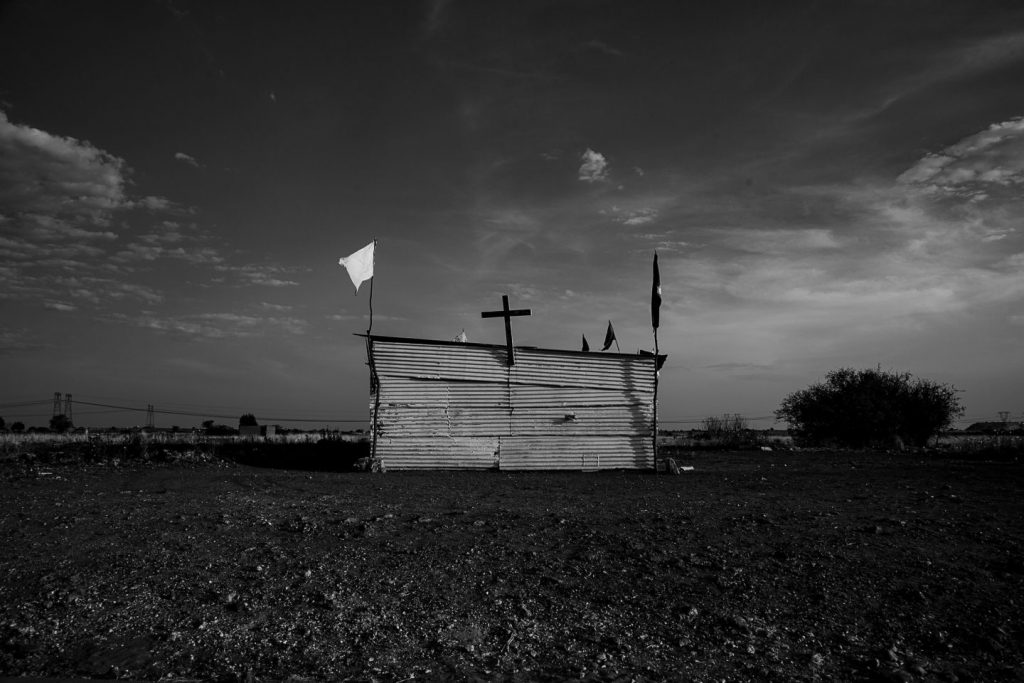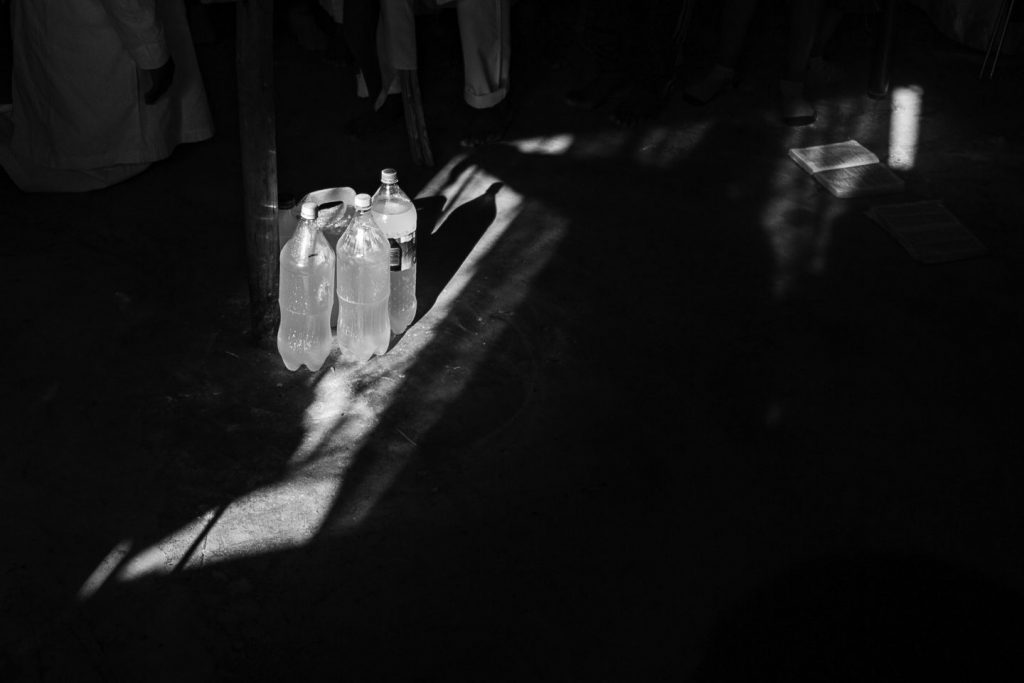Ikhaya Lika Moya: The Art of Healing

Sethembiso Zulu’s Ikhaya Lika Moya recently concluded its four-month residency at the William Humphreys Art Gallery in Kimberley. Mpho Matsitle immersed himself in its glory and jots down his thoughts for Art State.
Ke nqalo e khethehileng
“Rola meqhathatso ya hao, hoba nqalo e o leng ho yona ya halalela.”
It would have been the greatest of luck, as it was for me, to discover Sethembile Zulu’s debut exhibition at Kimberley’s William Humphreys Art Gallery (WHAG) from the Blue Boy wing. The exhibition, Ikhaya Lika Moya, is made up of photographs, video, music, and installations. It took up the entirety of the wide hallway wing called the Ramp, with a little spillage into the gallery’s Temporary Exhibitions wing and the Blue Boy wing. In the latter, at the entrance to the Ramp, a white door frame stands proud, inviting. Besides it more than a dozen pair of shoes are strewn about, as if their owners took them off in a last minute rush through the door, heeding the call kenang bohle baka se sa le teng. The doorframe, from afar, might strike you as a metal detector. But, I suspect, it is there to detect an element entirely different: what the cool and hip might call vibes, what the chakra huns may call energy, what my father would call ditomoso. Ditomoso, in this context, is any ill spirit that may reside in one’s soul.
God’s command for Moses to abandon his sandals was essentially a call on him to, in today’s parlance, check himself before he wrecks himself. In the same vein, the Apostle to the Gentiles chastised the Corinthians for their abuse of the Lord’s Supper: “If we were more discerning with regard to ourselves,” he berates them, “we would not come under such judgement.” What discernment is Zulu asking of us here to avoid damnation, as we enter his Home? Coming to art, like coming to the altar, demands a certain level of purity. Of the latter, the Taxman of Capernaum reports that the Son of Man taught that one should never approach the altar bearing a gift if they still have “nc!” with their brethren. In approaching Zulu’s art/altar, maybe we are being asked to leave our pre- and misconceptions at the door. We are invited to be.
Ikhaya lika moya
“Ikageleng areka, eo lo tla nthapelang go yona.”
Speaking at the panel discussion Through The Artists’ Lens organised by the William Humphrey’s Art Gallery, Zulu narrates how a dream led him to the church that became the site of the photographs in this exhibition, and therein he found that he was allowed the opportunity to just be. To scream if he wanted to, cry, dance, jump — without the need to explain to anyone the why of it all. He had found sanctuary, sediba se maphodi, a Home. In Ikhaya Lika Moya he explores and documents the congregation of the Ukuphila KwamaKrestu church near the Nancefield Hostel in Soweto, just being.

The temple, in the exhibition’s eponymous photograph, stands proud in the middle of the open veld and sky. At its centre a cross juts out towards the heavens, flanked by different flags on all corners of the corrugated iron structure, waving believers and heathens alike to come drink from life-giving well. At the WHAG, this photograph is by its lonesome self in a corner of the Ramp, just short left of the door. South African indigenous/ed spiritual and religious practices are often overlooked as sites of intellectual and artistic inquiry, especially on their own terms. That is; not as an anthropological exercise to explain or justify to the white gaze. In this photograph, Zulu captures the church contemplating itself, yet assured of its place in the world. Just being. Academics may deem it marginalised, ostracised, and whatnot, but Zulu’s photograph intervenes to remind us that the black church has always been and is the centre of its own world.
Tshebetso ea moea
“Hlomani izikhali zonke zikaNkulunkulu, ukuze nibe namandla okumelana namaqhinga kaSathane.”
The music is faint but unmistakably Zionist as Zulu ushers us inside the temple. It’s harmonious, vibrational, and incredibly velvety — the music. The expansiveness in these photographs belie the limited size of the temple as seen in the aforementioned photograph. The temple holds an entire universe. In it we are called to bear witness to the spirit at work. The first series of photographs, Hlomani Izikhali, are blurry aerial snapshots of congregants in circular motion, staffriding the holy train, around a bundle of staves — the spiritual armaments the Ephesians were advised to guard against the Devil’s evil tricks with. The photographs are complemented by an installation of the wooden staves of God in various designs hanging low from the ceiling, almost like a chandelier.
The next series, Yehla Moya Oyingcwele, is two medium close ups of women in the spirit. In the first photograph, a woman, head tilted back, almost fainting, is held up by another woman equally in a trance, suffering tshokodiso ya moea. The latter’s face is more pained than the former’s, almost wailing. Yet, precisely because she feels the pain of her sister, she supports her. It is great reminder that, especially in the face of the rampant propaganda that the PHD syndrome is our modus operandi, black people, black women particularly, have always had each other’s backs. Even as we fall apart, we refuse to succumb to sofasonke defeatism, but defiantly shout Mabaphile!
Matla a sona ke bophelo
“Rona re bana ba metsi; rona re buswa ke moea.”
Kimberley is not a forgiving place. With nary a hill to play hide and seek, the sun here has no pretensions of being shy. When I first came across Sethembile Zulu’s work in November of 2021, the temperature in the city was in the mid-thirties. I was en route to Taung — an equally unforgiving climate — when I decided to make a quick pit stop at the WHAG to quench my thirst. As I stood at the installation of the vibe detector door, simply titled Icango, scouring my soul for ditomoso, my eyes — usually nothing more than ornaments — shot right past the chandelier of holy rods, all the way to the exhibition’s spillage into the Temporary Exhibitions wing. There, bundled tightly in a tapered hexagon shape, lay bottles of water.

If ever I have anything akin to tshokodiso ya moea, it has always manifested itself when I encounter St John’s Brass Band’s November 2017 performance of Pula Tsa Lehlohonolo, and Muntu Vilakazi’s 2015 photograph Mass Therapy. Both these works concern themselves with water healing rituals. Sethembiso Zulu’s installation, Iswasho, completes the trinity. The water bottles, some adorned with multicoloured dithapo, roped me right in. I, too, was Home. I could immediately hear my father’s voice bellow; “metsi ke bophelo!” The installation forms part of a series with two photographs: Iswasho II shows a priest holding a quarter-full cup of milky sewasho, and in Iswasho I he is seen giving the healing drink to a kneeling woman. In the background, just under the priest’s hand, a boy, holding on to the temple’s pillar, watches the ritual vigilantly, probably waiting/hoping for his turn to drink from God’s bountiful cup. He’s not alone on the waiting list; behind him are three others, in ascending height, also keeping a watchful eye on the proceedings. The four children — the landlords of God’s kingdom — are the focus of this photograph.
The uniform translucent white plastic bottles with matching white caps in Iswasho are but an artistic approximation, the real thing is captured in another stunning solo photograph titled Iladi. Three two-litre Coca-Cola plastic bottles, two of them with labels expertly removed, and another bottle of no particular origin, all huddled around the temple’s supporting beam, hover towards the top left of the frame. It is right at that spot where a sliver of light shines through on an otherwise dark floor, presumably from the temple’s window. Towards the top right, the window admits a bit less light to illuminate the two open bibles placed on the concrete floor. One of these bibles is seen close up in Okweshumi, with a few silver coins presented as offerings on its open pages.
Ikhaya Lika Moya is a sliver of light in a dark world that everyone ought to hover towards, it is a life-giving wellspring for parched souls, and a befitting ode to the practice of healing. In it Sethembiso Zulu gives back to the black church, and black spirituality, the gift it gave him when he began his spiritual journey: the gift to just be. I am eternally grateful that I was blessed with an opportunity to drink from Zulu’s altar.
FEATURED IMAGE: Okweshumi by Sethembiso Zulu.